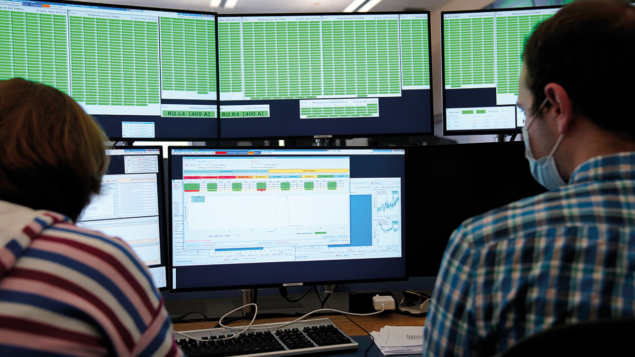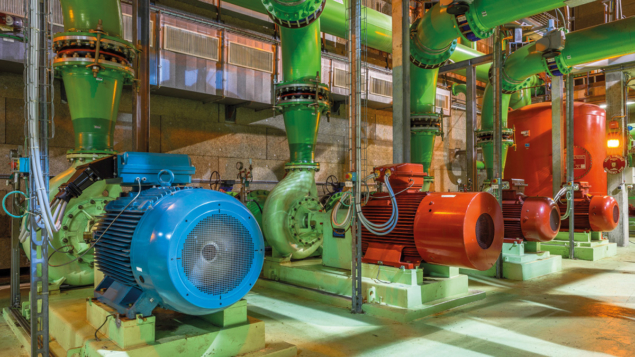From equipment procurement to knowledge-transfer initiatives, Giovanni Anelli, Anders Unnervik and Marzena Lapka provide a high-level tour of CERN’s unique research and innovation ecosystem.

CERN sits at the epicentre of a diverse innovation ecosystem. Developing and implementing the enabling technologies for the laboratory’s particle accelerators, detectors and computing systems is only possible thanks to the sustained support of a global network of specialist industrial and institutional partners. Those applied R&D and product development collaborations come in many forms: from the upstream procurement of equipment and services across multiple industry supply chains to the structured transfer of CERN domain knowledge to create downstream growth opportunities for new and established technology companies. Emphasising the role of big science in delivering broad societal and economic impacts, the following snapshots showcase a technology innovation programme that is, quite simply, one on its own.
Procurement: a world of opportunity
CERN is budgeted to spend CHF 2.5 billion (Euro 2.6 billion) on procurement of equipment and services for the period 2022–26 and is always looking to engage new industry suppliers. Contracts are awarded following price enquiries or invitations to tender. The former relate to contracts with an anticipated value below CHF 200,000 and are issued to a limited number of selected firms. Invitations to tender, meanwhile, are required for contracts with a value above CHF 200,000 and issued to firms qualified and selected based on a preceding open market survey. Prospective industry suppliers should visit https://procurement.web.cern.ch/ to register for CERN’s procurement database.
Procurement: amplifying the upsides

For industry suppliers, the benefits of doing business with CERN go well beyond direct financial returns on a given contract. Like all big science projects, CERN provides fertile ground for technology innovation. As such, industry partners are also investing in future visibility and impact within their given commercial setting. CERN, after all, is well known for its technological excellence, which means preferred suppliers must, as standard, push the boundaries of what’s possible, creating a virtuous circle of positive impacts versus firms’ product innovation, sustainable practices, profitability and competitiveness. A 2018 research study, for example, investigated whether becoming a CERN supplier was linked to enhanced innovation performance within partner companies, and it showed a statistically significant correlation between CERN procurement contracts and corporate R&D, knowledge creation and commercial outcomes (see “Further reading”).
Following the procurement roadmap
The LHC is undergoing a major upgrade to sustain and extend its discovery potential. Scheduled to enter operation in 2029, the High-Luminosity LHC (HL-LHC) project is a complex undertaking that requires at-scale industry engagement for all manner of technology innovations, whether that’s cutting-edge superconducting magnets or compact, ultraprecise superconducting RF cavities for beam rotation. What’s more, the machine’s enhanced luminosity (i.e. increased rate of collisions) will make new demands on the supporting vacuum, cryogenics and machine protection systems, while advanced concepts for collimation and diagnostics, beam modelling and beam-crossing schemes will also be required to maximise physics outputs. Industry is front-and-centre and has a pivotal role to play in delivering the core technologies needed to achieve the HL-LHC’s scientific goals. Down the line, even bigger opportunities will come into play as the HL-LHC draws to a close (in 2040 or thereabouts). Designs are now in the works for the proposed Future Circular Collider (FCC), an advanced research infrastructure that would push the energy and intensity frontiers of particle accelerators into uncharted territory, reaching collision energies of 100 TeV (versus the LHC’s current 13.6 TeV) in the search for new physics.
The engine-room of knowledge transfer
Although fundamental physics might not seem the most obvious discipline in which to find emerging technologies with marketable applications, CERN’s unique research environment – reliant as it is on diverse types of radiation, extremely low temperatures, ultrahigh magnetic fields and high-voltage power systems – represents a rich source of innovation spanning particle accelerators, detectors and scientific computing. Industry partnerships underpin CERN’s core research endeavour through the procurement of specialist services and co-development of cutting-edge components, subsystems and instrumentation – a process known as upstream innovation. Conversely, companies looking to solve innovation challenges are able to tap CERN’s capabilities to support technology development and growth opportunities within their own R&D pipeline – a process known as downstream innovation. In this way, companies and research institutes collaborate with CERN scientists and engineers to deliver breakthrough technologies ranging from cancer therapy to environmental monitoring, radiation-hardened electronics to banking and finance.
Knowledge transfer at CERN: unique technologies, unprecedented performance
The applied R&D and technology advances that underpin CERN’s scientific mission are a rich source of product innovation for companies working across multiple industry sectors. Industry collaborations with CERN scientists and engineers – including the projects below – are overseen by the laboratory’s Knowledge Transfer Group.
Next-generation radiotherapy

An R&D collaboration involving scientists from CERN and Lausanne University Hospital (CHUV) seeks to fast-track the development of a next-generation radiotherapy modality that will exploit very-high-energy electron (VHEE) beams to treat cancer patients. A dedicated VHEE facility, based at CHUV, will exploit the so-called FLASH effect to deliver high-dose VHEE radiation over short time periods (less than 200 ms) to destroy deep-seated tumours while minimising collateral damage to adjacent healthy tissue and organs at risk. The pioneering treatment system is based on the high-gradient accelerator technology developed for the proposed CLIC electron–positron collider at CERN. Teams from CHUV and its research partners have been performing preclinical studies related to VHEE and FLASH at the CERN Linear Electron Accelerator for Research (CLEAR), one of the few facilities available for characterising VHEE beams.
The future of transportation

CERN has unique capabilities in real-time data processing. When beams of particles collide at the centre of a particle detector, new particles fly out in all directions. Different detector systems, arranged in layers around the collision point, use a range of techniques to identify the resulting particles, generating an enormous flow of data. Similar challenges apply to the development of autonomous vehicles, with the need for rapid interpretation of a multitude of real-time data streams generated under normal driving conditions. Zenseact, owned primarily by Volvo Cars, worked with CERN scientists to optimise machine learning algorithms, originally developed to support LHC data acquisition and analysis, for collision-avoidance scenarios in next-generation autonomous vehicles.
Sustainability and energy-efficiency

Another high-profile innovation partner for CERN is ABB Motion, a technology leader in digitally enabled motor and drive solutions to support a low-carbon future for industry, infrastructure and transportation. The partnership has been launched to optimise the laboratory’s cooling and ventilation infrastructure, with the aim of reducing energy consumption across the campus. Specifically, CERN’s cooling and ventilation system will be equipped with smart sensors, which convert traditional motors, pumps, mounted bearings and gearing into smart, wirelessly connected devices. These devices will collect data that will be used to develop “digital twins” of selected cooling and ventilation units, allowing for the creation of energy-saving scenarios. Longer term, the plan is to disseminate the project learning publicly, so that industry and large-scale research facilities can apply best practice on energy-efficiency.
Intellectual property: getting creative
A curated portfolio of intellectual property (IP) policies provides the framework for transferring CERN’s applied R&D and technology know-how to industry and institutional partners. Democratisation is the driver here, whatever the use-case. Many of the organisation’s projects, for example, are available via CERN’s Open Hardware Repository under the CERN Open Hardware Licence, offering a large user community the chance to transform prototype products and services into tangible commercial opportunities. CERN also encourages the creation of new spin-offs – companies based, partially or wholly, on CERN technologies – and supports such ventures with a dedicated IP policy. Custom licensing opportunities are available for more established start-up businesses seeking to apply CERN technologies within an existing product development programme.
Innovation partnerships: a call to action
The Knowledge Transfer team at CERN is exploring a range of innovation partnerships across applied disciplines as diverse as energy and environment, healthcare, quantum science, machine learning and AI, and aerospace engineering. The unifying theme: to translate CERN domain knowledge and enabling technologies into broader societal and economic impacts. Companies should visit CERN’s Knowledge Transfer website (https://kt.cern/) to learn more about partnership opportunities, including R&D collaborations; technology licensing; services and consultancy; and starting up a new business based on CERN technology.
IdeaSquare: networking young innovators
IdeaSquare is CERN’s platform for early-stage collaborations between students, scientists, other CERN personnel and relevant organisations working across multiple disciplines. The initiative operates at what it calls the “fuzzy front end” of the R&D and innovation process and seeks to “trigger transformations in the way we think about societal challenges and…identify solutions that will have a real impact on people’s lives”. In this way, IdeaSquare ties science innovation at CERN to the UN’s Sustainable Development Goals, engaging young innovators in the CERN Entrepreneurship Student Programme (CESP), for example, or Challenge-Based Innovation (CBI). Other activities include selected EU R&D projects; prototyping and innovation workshops; as well as international educational programmes. Prospective partners should visit https://ideasquare.cern and https://kt.cern/cesp for more information about the latest opportunities.
Further reading
P Castelnovo et al. 2018 The economic impact of technological procurement for large-scale research infrastructures: evidence from the Large Hadron Collider at CERN Research Policy 47 1853.








